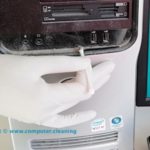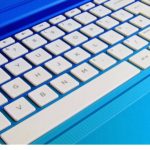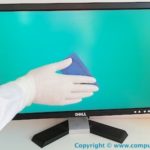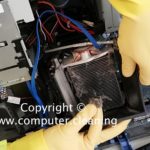Disinfecting uses chemicals to kill 99.999% of germs on hard, non-porous surfaces or objects.
- does not necessarily clean dirty surfaces or remove germs;
- kills germs on contact (when the disinfectant sits visibly wet, or “dwells,” on the surface for a specified length of time) after the surface has been cleaned;
- only works on hard, nonporous surfaces. Carpets and upholstery and other porous surfaces cannot be sanitized or disinfected with a chemical product;
- is temporary! As soon as a surface has been touched or coughed, sneezed or breathed on, germs start growing on it again.
Some germs are very hard to kill, while others are easily killed by many disinfectants and even plain soap.
Disinfectants are antimicrobial pesticides and must be registered with the U.S. EPA and the California Department of Pesticide Regulation (DPR) or similar agencies in other states.
Some devices can be used to disinfect; for example, machines that apply steam to surfaces. These devices are very effective, work quickly, and use no chemicals. Some are mops and others look like a canister vacuum with attachments for use on different surfaces. They can also disinfect surfaces that chemical disinfectants cannot, such as upholstery and carpets. Dust mites that live in these surfaces are also eliminated by these devices.
Because disinfectants are pesticides designed to kill or inactivate germs, you should make sure you need them for the specific task. The overuse and misuse of these products is a growing public health and environmental concern. Studies have found that the use of some disinfectant products is creating microbes that can mutate into forms that are resistant to particular disinfectants or that become superbugs. These resistant germs are also harder to kill with antibiotics.
The U.S. EPA regulates sanitizers and disinfectants as pesticides. The U.S. Food and Drug Administration (FDA) regulates sanitizers used on food contact surfaces. Sanitizing and disinfecting require the use of
- EPA-registered chemical sanitizers and disinfectants;
- Disinfecting/sanitizing water-based devices (for example, those that use steam).
A pesticide is any substance or mixture of substances intended for preventing, destroying, repelling, or mitigating any pest. We think of pesticides when we think of getting rid of ants or cockroaches, but germs are also pests and the products used to kill them are pesticides.
Incorrectly using a disinfectant may kill the weaker germs, but the more resistant germs survive. Incorrect use includes;
- disinfecting a dirty surface;
- wiping or rinsing the disinfectant off the surface before the recommended dwell (contact) time is over;
- not using the recommended dilution ratio (not concentrated enough);
- using a combination disinfectant/cleaner without first removing visible dirt from the surface.
When deciding on what products to use on a surface, there are several factors to consider:
➊ Whether the surface is porous or nonporous.
- Manufacturers design their antimicrobial products – and the U.S. Environmental Protection Agency (EPA) registers them – on the basis of the surfaces they are meant to be used on and what the surfaces are used for (for example, food preparation).
- Different types of surfaces require different types of products and methods for removing or killing germs.
➋ Whether it is likely that the surface is touched by many people and will come in contact with broken skin or mucous membranes. These surfaces will require disinfection. If a surface is contaminated with germs but no one is touching it, it doesn’t need to be disinfected. It is best to avoid unnecessary use of chemicals in that area.
➌ Whether the surface requires
- sanitizing which removes most germs to the level of 99.9% or more on non-food contact surfaces;
- disinfecting (to kill virtually everything).
Remember, some infectious diseases are spread in the air. Disinfecting surfaces will not prevent the spread of these diseases! The only way to prevent the spread of airborne diseases is by our behaviours. See Section 6 on non-chemical strategies for reducing the spread of infectious disease.





